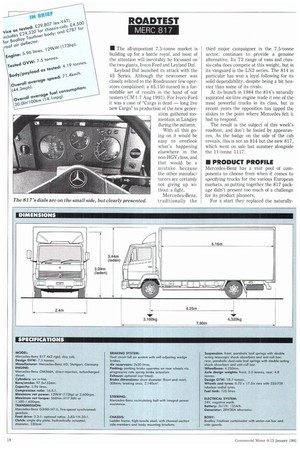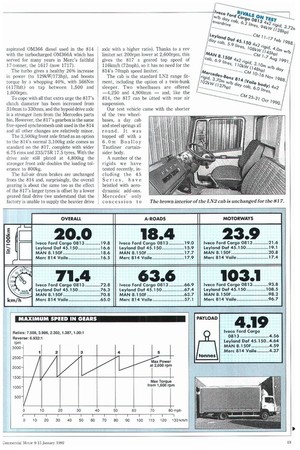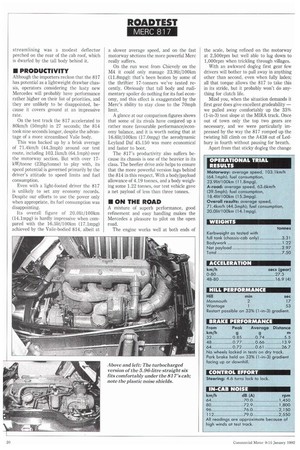The all-important 7.5-tonne market is building up for a battle
Page 20

Page 21

Page 22

Page 23

If you've noticed an error in this article please click here to report it so we can fix it.
royal, and most of the attention will inevitably he focussed on the two giants, Iveco Ford and Leyland Daf.
Leyland Daf launched its attack with the 45 Series. Although the newcomer was closely related to the Roadrunner few operators complained: a 45.150 turned in a formidable set of results in the hand of our testers (CM1-7 Aug 1991). For Iveco Ford it was a case of "Cargo is dead — long live new Cargo" as production of the new generation gathered momentum at Langley during the autumn.
With all this going on it would be easy to overlook what's happening elsewhere in the non-HGV class, and that would be a mistake because the other manufacturers are certainly not giving up without a fight.
Mercedes-Benz, traditionally the third major campaigner in the 7.5-tonne sector, continues to provide a genuine alternative. Its T2 range of vans and chassis-cabs does compete at this weight, but in its vanguard is the LN2 series. The 814 in particular has won a loyal following for its solid dependability, despite being a bit heavier than some of its rivals.
At its launch in 1984 the 814's naturally aspirated six-litre engine made it one of the most powerful trucks in its class, but in recent years the opposition has upped the stakes to the point where Mercedes felt it had to respond.
The result is the subject of this week's roadtest, and don't be fooled by appearances. As the badge on the side of the cab reveals, this is not an 814 but the new 817, which went on sale last summer alongside the 11-tonne 1117.
• PRODUCT PROFILE Mercedes-Benz has a vast pool of components to choose from when it comes to specifying trucks for the various European markets, so putting together the 817 package didn't present too much of a challenge for its product planners.
For a start they replaced the naturally aspirated 0M366 diesel used in the 814 with the turbocharged 0M366A which has served for many years in Merc's faithful 17-tonner. the 1617 (now 1717).
The turbo gives a healthy 26% increase in power (to 129kW/173hp), and boosts torque by a whopping 40%, with 566Nm (4171bft) on tap between 1,500 and 1.60Orpin.
To cope with all that extra urge the 817's clutch diameter has been increased from 310mm to 330mm, and the hypoid drive axle is a stronger item from the Mercedes parts bin. However, the 817's gearbox is the same five-speed synchromesh unit used in the 814 and all other changes are relatively minor.
The 3,500kg front axle fitted as an option to the 814's normal 3,100kg axle comes as standard on the 817, complete with wider 6.75 rims and 235/75R 17.5 tyres. With the drive axle still plated at 4,800kg the stronger front axle doubles the loading tolerance to 800kg.
The full-air drum brakes are unchanged from the 814 and, surprisingly, the overall gearing is about the same too as the effect of the 817's larger tyres is offset by a lower geared final drive (we understand that the factory is unable to supply the heavier drive
axle with a higher ratio). Thanks to a rev limiter set 200rpm lower at 2,600rpm, this gives the 817 a geared top speed of 116km/h (72mph), so it has no need for the 814's 70mph speed Limiter.
The cab is the standard LN2 range fitment, including the option of a twin-bunk sleeper. Two wheelbases are offered -4,250 and 4,900mm and, like the 814, the 817 can be fitted with rear air suspension.
A number of the rigids we have tested recently, including the 45 Series, have bristled with aerodynamic add-ons. Mercedes' only concession to streamlining was a modest deflector perched on the rear of the cab roof, which is dwarfed by the tall body behind it.
• PRODUCTIVITY
Although the importers reckon that the 817 has potential as a lightweight drawbar chassis, operators considering the lusty new Mercedes will probably have performance rather higher on their list of priorities, and they are unlikely to be disappointed, because it covers ground at an impressive rate.
On the test track the 817 accelerated to 80km/h (50mph) in 27 seconds; the 814 took nine seconds longer, despite the advantage of a more streamlined Valle body.
This was backed up by a brisk average of 71.4kna/h (44.3mph) around our test route, including 103.1km/h (64.1mph) over the motorway section. But with over 17kW/tonne (23hp/tonne) to play with, its speed potential is governed primarily by the driver's attitude to speed limits and fuel consumption.
Even with a light-footed driver the 817 is unlikely to set any economy records. Despite our efforts to use the power only when appropriate, its fuel consumption was disappointing.
Its overall figure of 20.01it/100km (14.1mpg) is hardly impressive when compared with the 16.5lit/100km (17.1mpg) achieved by the Vaile-bodied 814, albeit at a slower average speed, and on the fast motorway sections the more powerful Merc really suffers.
On the run west from Chievely on the M4 it could only manage 23.91it/1001un (11.8mpg): that's been beaten by some of the thriftier 17-tonners we've tested recently. Obviously that tall body and rudimentary spoiler do nothing for its fuel economy, and this effect is exaggerated by the Merc's ability to stay close to the 70mph limit.
A glance at our comparison figures shows that some of its rivals have conjured up a rather more favourable performance/economy balance, and it is worth noting that at 16.61it/100km (17.0mpg) the aerodynamic Leyland Daf 45.150 was more economical and faster to boot.
The 817's productivity also suffers because its chassis is one of the heavier in its class. The beefier drive axle helps to ensure that the more powerful version lags behind the 814 in this respect. With a body/payload allowance of 4.19 tonnes, and a body weighing some 1.22 tonnes, our test vehicle gave a net payload of less than three tonnes.
• ON THE ROAD
A mixture of superb performance, good refinement and easy handling makes the Mercedes a pleasure to pilot on the open road.
The engine works well at both ends of the scale, being refined on the motorway at 2,500rpm but well able to lug down to 1,000rpm when trickling through villages.
With an awkward dogleg first gear few drivers will bother to pull away in anything other than second, even when fully laden; all that torque allows the 817 to take this in its stride, but it probably won't do anything for clutch life.
Mind you, when the situation demands it first gear does give excellent gradeability we pulled away comfortably up the 33% (1-in-3) test slope at the MIRA track. Once out of town only the top two gears are necessary, and we were particularly impressed by the way the 817 romped up the twisting hill climb on the A438 out of Ledbury in fourth without pausing for breath.
Apart from that sticky dogleg the change itself is good, although anyone spending a day on urban deliveries might find the clutch a touch on the heavy side.
Through the winding secondaries of our A-road section the 817 proved to be a confident handler, combining positive steering, controlled cornering and firm progressive brakes.
• CAB COMFORT
The design of the LN2 cab has stood the test of time, and although the interior might not be as adventurous as, say, the Leyland 45 Series, it is none the worse for that.
Noise levels are subdued, the instrumentation and controls are straightforward and, despite the unusual chocolate colour scheme (ranging from Caramac through to Bournevile), the trim is durable and easy to clean. Mercedes fits a dual passenger seat to the 817 as standard. This allows three people to sit abreast in reasonable comfort, at the expense of the useful central storage box. The larger seat does not hinder cross-cab access, which remains good; getting in and out of the cab via the high single step is also reasonably easy, but would be helped by bigger grab handles. A wide-angle nearside mirror would have been welcome for those awkward junctions.
SUMMARY
Adding a turbocharged engine to the proven 814 has produced a vehicle with a fairly predictable mixture of abilities.
Performance is superb, even when fully laden, and the combination of a torquey motor with a chassis that handles well produces a marvellously driveable package.
Fuel bills generally rise in sympathy with performance, and the 817 is probably a touch undergeared, so pulling a tall body along at maximum speed is hardly condusive to good fuel economy. Also on the debit side, the new Merc 7.5-tonner is no lightweight, which could limit its desirability for highpayload applications.
At £24,520, the 817 costs £1,950 more than the 814; this puts it alongside its two most obvious rivals, the new Iveco Ford Cargo 80E18 at £24,850 and Leyland Daf 45.160 at £24,690.
On a more general note, we find it diffi cult to imagine what sort of work justifies a 7.5-tonne solo rigid with this kind of power. If you need to move fast on motorways a more aerodynamic body would probably deliver the goods with less power and better fuel consumption.
One last point: 7.5-tonners often end up in the hands of untrained drivers — that is, after all, part of their attraction — and we find the thought of a unladen 817 (or similar) being driven by someone without prior training rather disturbing.
This is something that potential buyers should consider carefully.
111 by Peter Watt
































































